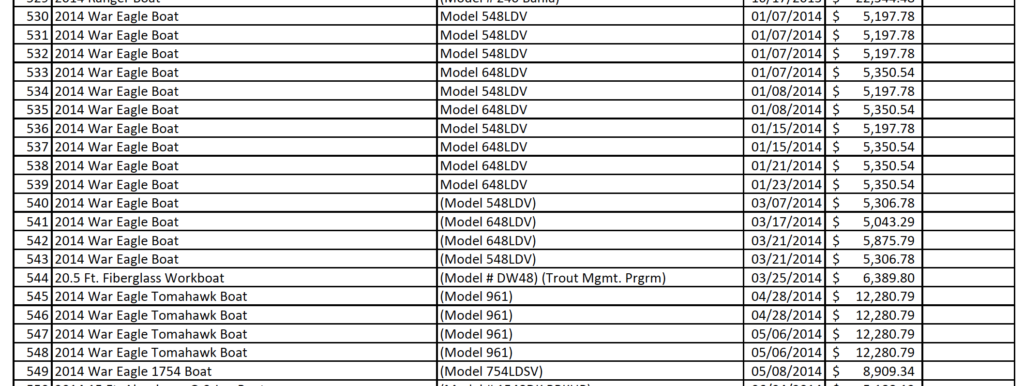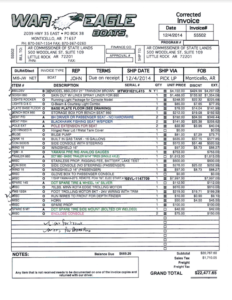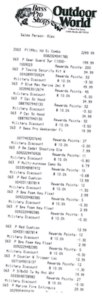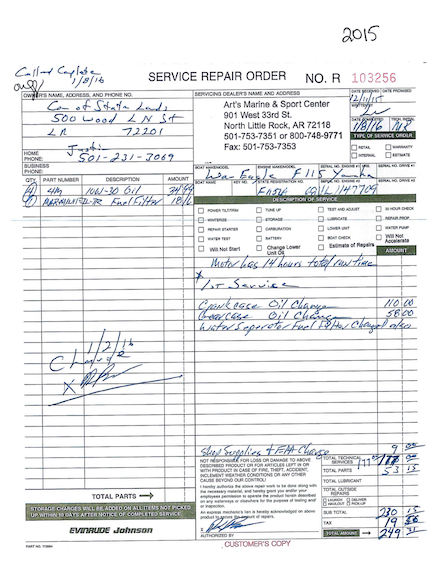Just sit right back and you’ll hear a tale…
John Thurston, the current Commissioner of State Lands (COSL) and candidate for Secretary of State, likes to say that his tenure as Land Commissioner has been without “a hint of corruption or any controversy.” He’s even said it on video.
Of course, assuming that statement is true, it would be fair to ask whether it is true because there have been no improper actions or simply because most people don’t pay attention to the COSL’s doings. In an effort to answer that question, I started poking around and talking to people who might have some insight.
It didn’t take much digging before a rumor surfaced that Thurston had purchased a fishing boat with state funds. Sure enough, a request for public records turned up the purchase of an 18.5-foot War Eagle model 860LDSV for $22,447.65, which included two Blackhawk Fishing Seats ($141 each) and an upgraded 115HP Yamaha outboard engine ($7,997).
The boat was ordered on October 2, 2014, but was not picked up in Monticello at the War Eagle factory until December 4, 2014. Despite that two-month lag between ordering and pickup, however, it appears that the folks at the COSL office could not wait to go on a shopping spree for other things that they needed along with the boat. Less than three weeks after ordering the boat, on October 20, one or more people from the COSL office went to Bass Pro, during business hours, and spent $3,999.96 on a variety of things including (but definitely not limited to) a fish/depth finder ($2,299.99), two “Deluxe Fishing Vest” life vests ($59.99 each), two “Mustang Survival Bass Competition” inflatable PFDs ($249.99 each), two Under Armour balaclava-style masks ($34.99 each), a “Weekender Fishing Tackle Bag” ($19.99), three pair of shooting glasses, and two pair of camo pants.
Of course, no fishin’ boat in Arkansas can be complete without a trip to one certain store. The next day, one or more COSL employees went to Wal-Mart, again during business hours, and spent $305.06 on, among other things, flashlights, needle-nose pliers, a 6-ton bottle jack, a tool set, and (of course) two pair of men’s rubber boots (sizes 10 and 12 respectively).

The downside of doing all this shopping nearly six weeks before they actually picked up the boat, however, was that they needed somewhere to store all of that gear. So, by the end of October, the COSL had rented storage space at Scott’s Storage in Maumelle. Like something from MTV’s old “Pimp My Ride,” this new boat was going to be much too fine to park out in the lot, or even under a shed roof for that matter. No, sir. This boat–which we’ll just go ahead and christen as “The Andrea Fail”–needed a roomy, 14 x 30 x 14 indoor RV-storage unit that cost the COSL $1,686.93 for a year, which they paid in advance, since paying for 12 months up front got them a 13th month for free.
Time passed, as it is wont to do, and someone from the COSL staff went to Monticello on December 4, 2014, and picked up the finished boat. A week later, on December 11, then-chief counsel of the COSL, Kenneth Burleson, took the boat to have the aforementioned depth/fish finder installed, which cost $337.95. The installation was completed, and the boat was returned to the COSL on December 15.
All told, between October 2 and December 15, 2014, John Thurston’s office spent $28,777.55 on the purchase, outfitting, storage, and customization of what appears, for all intents and purposes, to be a fishing boat.
You might be wondering if such a nautical purchase is common in the COSL office. Well, a search of public records and a couple of conversations with staff of previous Land Commissioners revealed that no prior COSL administration had purchased a boat, fishing or otherwise. So, what gives? What’s the alleged reason behind this boat?
I posed that question to COSL chief counsel Diane Schwartz. Her response:
In 2013, the legislature added a provision to the Code authorizing the removal of certain debris from state waterways. See Act 552 of 2013 (amending Ark. Code Ann. § 22-6-202). After the change in the Code, the COSL began receiving a variety of complaints from areas throughout the state regarding debris removal, in addition to the concerns and complaints that had been historically lodged with the office. The uncertainty of the increased scope of the waterways division and the need for independent and quick responses ultimately necessitated the addition of a watercraft to the COSL motor-vehicle fleet. The watercraft was outfitted with a device to ascertain the location and extent of the debris or other obstructions located on or in the river or lake beds deemed navigable that would fall under the COSL’s authority. The device added was identical or similar to the devices used by other state agencies for like purposes.
Interesting, at least on the surface. But here’s the thing: even before I asked Ms. Schwartz for the reasoning, I was pretty sure that they would defend the boat purchase through that 2013 change in the law. (Admittedly, I didn’t expect them to straight-up misstate what the statute actually required or allowed the COSL to do, but that’s neither here nor there, I guess.)
The law in question began as House Bill 1653 in 2013, co-sponsored by then-Sen. Jon Woods. Regarding debris, the law specifically states:
(e)(1) The Commissioner of State Lands, or at the request of the Commissioner of State Lands, the Attorney General, may institute an action in a court with proper venue and subject matter jurisdiction over submerged lands or the Pulaski County Circuit Court to remove a structure or debris resting on the submerged lands of the navigable waters of the state or to enjoin the construction or placement of a structure upon the submerged lands.
(2) If a court finds that a structure or debris is on the submerged lands of the state without permission from the Commissioner of State Lands, the court may order the owner of the structure or debris to:
(A) Remove the structure or debris; and
(B) Pay the expenses of removing the structure or debris.(3) If the structure or debris has been removed by the state or a local government, the judge may order the owner to:
(A) Reimburse the state or local government for the costs of removal; and
(B) Pay the state or local government its court costs and reasonable attorney’s fees.
So, if the COSL learns of debris or an unauthorized structure below the waterline of a navigable body of water, the COSL or the Attorney General (at COSL request) can file suit in Pulaski County Circuit Court to have it removed.
Notably, the statute does not say that the COSL–an office that had never before owned a boat at the time of this statute’s passage–was required to go out and examine alleged debris/structures before it could file suit. The statute did not say that the COSL was authorized to buy a boat and to take that duty on himself, even if he wanted to.
Rather, the statute explicitly said
(d) The Commissioner of State Lands may:
(1) Enter into agreements and partnerships with other agencies to carry out the intent of this section;
(2) Require the removal of an existing structure that occupies the submerged lands of a navigable stream, river, or lake; or
(3) Require compensation to the Commissioner of State Lands by the owner for the continued use of submerged lands.
Interesting. So, to the extent that the 2013 law required some state agency with a boat to go out and examine debris/structures for purposes of evaluation and potential removal, the statute specifically allowed the COSL to “enter into agreements and other partnerships with other agencies to carry out the intent of this section.” If only there was a state agency that had a lot of boats. Maybe one that had trained boaters and hours of experience with underwater analysis.
Oh, wait! There is one of those. It’s called Arkansas Game & Fish Commission. They have a whole fleet of boats. Around the time the COSL purchased its boat, Game & Fish had approximately 600 various boats, including nineteen 2014 War Eagle boats similar to the one the COSL bought:

The fact that Game & Fish could have been used to carry out the requirements of the statute, however, is only a piece of why the COSL using the statute as an excuse to buy that boat just doesn’t add up. Let’s take it piece by piece:
1. The statute was passed in the 2013 regular session and signed by the Governor on April 1, 2013. There was no emergency clause on the bill, so the law would have taken effect on August 15, 2013, ninety days after sine die adjournment. Yet…the COSL did not even order a boat until October 2, 2014, and didn’t get that boat until December 4 of that year, over sixteen months after the effective date of the statute. What were they doing with the “variety of complaints from areas throughout the state” that they received in those sixteen months? Or did the complaints not start rolling in for over a year? Funny you ask because…
2. After I received the explanation from Ms. Schwartz about why the boat was purchased, I requested all of the “variety of complaints from areas throughout the state regarding debris removal” that the COSL had received following the passage of the statute. However, I was informed, “to the best of my knowledge, all complaints regarding debris were received by telephone.” It is stunningly convenient that the same flood of complaints that was used to justify purchasing a fishing boat was all done via telephone and without a single contemporaneously created record of those calls. (How would someone other than the call-taker even know what was being complained of or where it was located? Who knows?!)
What kind of effort must it have taken to respond to the “variety of complaints” that they received? Well…
3. The boat was received back from H20 Sportz with the depth/fish finder installed on December 15, 2014. From that point until the boat received its first annual service on December 11, 2015, the boat’s engine had a whopping 14 hours of total run time.
Maybe it’s just me, but 14 hours of run time does not seem like a lot. It certainly doesn’t seem like enough to justify buying a boat. Assuming it was enough time to justify buying the boat, though, who would have been the COSL employee to handle this? After all…
4. No one in the COSL office has (or had) any training in how to use a depth/fish finder to locate debris, how to evaluate debris for possible removal, how to best approach potential underwater debris in a V-hull boat, SCUBA, or anything of the like. The only training that was received was on October 30, 2014, when some of the COSL staff received a 6-hour “boating safety” course. No one has taken a single course that would explain why they went shopping for fishing-style life vests, specific types of clothes, and the like. Yet, it’s almost as if, without any training in the official use of the boat, the people doing the shopping knew exactly what they needed, gear-wise, for some activity. What activity? Well…
5. This boat was specifically outfitted with fishing seats. If all you were doing was using the boat to get to reported debris/structures, why would you need raised, 360-degree swiveling fishing seats rather than the fixed seats that come standard on the War Eagle 860LDSV? Game & Fish did not seem to need those fancier seats for their boats, and they are on the water WAY more than 14 hours per year. They’re on different kinds of water, in fact, all around the state. Whereas…
6. Ms. Schwartz said that the boat has been used to respond to complaints “throughout the state.” Yet, in the lifetime of the boat, all the fuel purchases were made in North Little Rock or Little Rock, except for one in El Dorado at 8 pm on a Wednesday in October, which was well after dark. And speaking of fuel purchases, they bought gas 6 times in all of 2015, one time in 2016 (almost a year after the last gas purchase in 2015), one time last month, and (as a testament to the intensity of the boat’s use) a total of zero fuel purchases were made for it in 2017.


7. If this was for state business, why keep it in Maumelle for $1,800+/year? The Game & Fish building on Natural Resources Drive has plenty of boat storage where the COSL could surely have kept its boat. Why pay $6,763.78 (and counting) to store that boat at a private storage facility in Maumelle? I honestly can’t come up with a reason for this one.
8. As already mentioned, nothing in that statute requires the COSL to go examine complaints of debris or underwater structures. To the extent there were some that needed examination before the COSL could act on the complaint, the statute did empower the COSL to enter into agreements with other agencies to help with that task. Yet, when I asked for copies of any such agreements, I was told, “In my experience, the COSL has not entered into agreements with any other agencies with respect to assisting in any of these duties.”
So, despite complaints from “throughout the state” that required a “quick response,” despite the COSL boat only being gassed up a total of eight times in four years, and despite a complete lack of training in performing most of the tasks required to evaluate debris and underwater structures, the COSL has not actively engaged a single agency to consistently help with any of this, even in the outlying areas?
When you look at it that way, the whole “we needed this boat to address a large volume of citizen complaints” seems rather, well…fishy.




